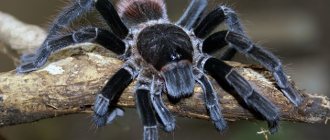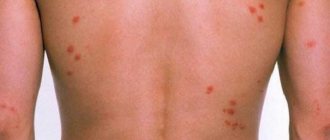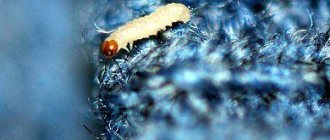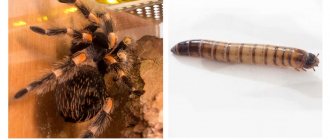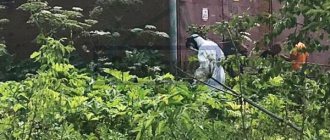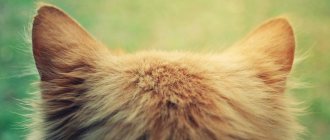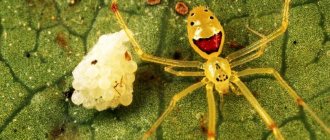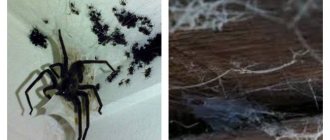Wasp Spider,
or
Bruennichi's argiope (
Argiope bruennichi )
is an arthropod that belongs to the class Arachnida, order Spiders, suborder Opisthothelae, infraorder Araneomorpha spiders, superfamily Araneoidea, family orb-weaving spiders, subfamily Argiopinae, genus Argiope.
International scientific name: Argiope bruennichi
(Scopoli, 1772).
The species name for the spider was given in honor of Morten Trane Brünnich, a zoologist from Denmark. Due to its warning coloration with black and yellow stripes, this representative of arachnids is often found under the name wasp spider, and in some countries it is called the tiger spider or zebra spider. Some people incorrectly call it the bee spider.
On the fourth stripe from the cephalothorax, two small tubercles are clearly visible.
The male wasp spider is inconspicuous, does not look like a wasp at all and is painted in a light beige color, on which 2 longitudinal dark stripes are barely visible.
The wasp spider has 6 pairs of limbs: 4 pairs of walking legs, 1 pair of chelicerae (jaws) with movable claws, with which the striped spider grabs prey, and 1 pair of pedipalps, which perform the function of touch.
In individuals of both sexes, the legs are long and thin, brownish in color. The limbs of females are decorated with alternating bright dark and light rings, very similar to stockings. In males, the rings on the limbs are faded and blurred. Large bulbs, their reproductive organs, are clearly visible on the pedipalps of male wasp spiders.
The respiratory organs of the wasp spider are represented by a pair of lungs and trachea, opening with one spiracle in front of the arachnoid warts.
Where does the wasp spider (Argiope Brünnich) live?
The wasp spider is a fairly numerous species. It is widespread in the countries of North Africa, Asia Minor and Central Asia, India, China, Korea, Japan and the USA. It is also a common arachnid in Central and Southern Europe, Kazakhstan, Crimea and the Caucasus. In Russia, the spider wasp was noticed in several regions: Chelyabinsk, Saratov, Ulyanovsk, Tambov, Oryol, Lipetsk, Penza and Bryansk. Probably due to the increase in average annual air temperature, Argiope Brünnich also began to be noticed in the Tula, Ryazan regions and in the Moscow region. According to the latest data, the black and yellow wasp spider began to appear in the Kaluga region, as well as in the Novgorod region on the territory belonging to the Rdeisky Nature Reserve.
The wasp spider's favorite habitats are located in areas exposed to the sun: fields, lawns, along roadsides, forest clearings and forest edges. The black-and-yellow striped wasp spider places its hunting nets on various low vegetation, giving particular preference to xerophilous plants growing in particularly dry areas of the area.
A unique feature of all orb weavers, including the wasp spider, is their ability to move considerable distances thanks to their web threads, picked up by rising air currents. This manner of settlement has led to the fact that some southern populations often end up in northern territories.
The most famous green spiders living in Russia
The green spider in Russia is represented by three species. Their names are lynx spider, micromata greenish, and cheiracanthium.
This is exactly the list of arthropods that is returned by browser search engines for the query “green spiders in Russia photos and names.”
Lynx spider
The lynx spider (family Oxyopidae) received its name due to the hunting method characteristic of the predator.
This spider does not weave a web, it waits for its prey, sitting on a plant, and then attacks it.
Its special ability, the ability to jump considerable distances, just like a lynx or a cat, justifies the name of the species.
The lynx spider is a small green spider, Russia is the habitat for small individuals of this species. Females of such arthropods are twice as large as males; the average size of an adult female is usually about 2 – 2.2 cm. Male green spiders in Russia do not reach more than one centimeter.
Argiope Brünnich's web
Like all orb weavers, the wasp spider is fluent in the art of weaving webs, and its spiral trapping nets are large wheel-shaped nets with two pronounced stabilimentum in the middle.
The stabilimentum is a thickened zigzag pattern on the web, which can have different shapes: linear, circular, cruciform.
A notable feature of the wasp spider’s web is that there are two such patterns at once, which diverge from the middle and are located opposite each other. Scientists have found that the main reason for this artistic weaving is the ability of the multilayer insert to reflect ultraviolet rays, thereby attracting insects.
The wasp spider weaves a complex web of multilayer threads thanks to the structure of the limbs characteristic of orb-weavers. The last pair of legs, equipped with three simple claws and serrated setae, has a special spike-shaped appendage that allows it to weave intricate webs from individual threads.
The female, sitting in the center of the web (usually upside down), resembles the letter “X” because her widely spaced legs of the first and second, as well as the third and fourth pairs are placed very close to each other.
The wasp spider, like most representatives of the order, weaves its web at dusk, and the whole process lasts no more than an hour. Typically, the web stretches between plants no higher than 30 cm from the surface of the ground. In case of danger, a disturbed wasp spider throws its catching nets and tries to hide on the ground.
What does a wasp spider eat?
The strong trapping nets of the wasp spider most often catch representatives of the order Orthoptera: crickets, etc. Argiope Brünnich also preys on fillies. The feeding method of the Argiope spider is typical for most arachnids: as soon as the prey insect is in the nets, the spider quickly approaches and bites the victim, injecting poison into it. Then he entangles the future “dinner” with the threads of his web and waits until, under the influence of digestive enzymes, the caught prey becomes suitable for consumption. After this, it simply sucks up the liquid food, leaving only the chitinous shell of the insect.
Seeing a spider in a dream means that you will be attentive and active in your work, and luck will thank you for this.
Seeing a spider weaving its web means that you will be calm and happy in your home.
Killing a spider in a dream foretells that you will quarrel with your wife or lover.
If a spider bites you in a dream, you will become a victim of betrayal, and your work will suffer due to the fault of your enemies.
If you see in a dream that you are surrounded by many spiders hanging on their webs, this promises you an unusually favorable combination of circumstances: good health, good luck, the support of your friends.
To dream that you have stumbled upon a web with a huge spider means, despite dangerous connections, quick success in life.
A dream in which a very large and very small spider approaches you at the same time means that you will succeed in business and will more than once rejoice at your immense luck; however, if a huge spider bites you in a dream, your enemies will steal your luck. If you are bitten by a small spider, then minor attacks and envy will bother you.
If you dream that you are running away from a large spider, it means that luck will leave you under humiliating circumstances. If you kill this spider, you may take a worthy position. However, if he later comes to life and chases you again, then you will be oppressed by illness and the variability of fortune.
If a girl dreams that golden spiders are crawling around her, then her happiness is not far off and she will soon be surrounded by new friends.
Interpretation of dreams from Miller's Dream Book
Subscribe to the Dream Interpretation channel!
Subscribe to the Dream Interpretation channel!
The family of Lynx spiders is similar in lifestyle to jumpers: they do not weave webs, but pursue prey on plants, making jumps and short runs. These spiders are characterized by long spines on their legs.
A spider crawls up or down a wall: a sign
Values:
- A spider crawls up the wall - there will be prosperity, food and peace in the house. All family members will get along.
- A spider crawls down the wall - you will soon be haunted by wastefulness and financial difficulties. Perhaps there will be quarrels in the house.
- Spider on the ceiling - so that peace always reigns in your home, you should make a rearrangement. A spider on the ceiling portends positive changes.
Where the spider crawls: the meaning of folk beliefs
Green lynx spider Peucetia viridans
The lynx spider gets its name because it pounces on its prey like a cat. These skilled hunters can leap distances up to 40 times their body length and often leap upward to catch flying insects. But there is an exception - the American green lynx spider. This is a patient predator that prefers to watch for prey among the grass.
The green lynx spider is found in the southern states, northern California, Central America and Venezuela. In North America, this is the largest representative of the family: the female’s body size can reach 22 mm (males are smaller and slimmer, only 12 cm long). At the end of the season, the green lynx spider tends to change its color to a paler, yellow color, which is associated with degradation of pigments. But it is known that pregnant females can change their color within 16 days to match their background. Spiders living in California are not grass-green, but yellow in color. This allows them to hide in the buckwheat fields in which they have settled there. These diurnal spiders sometimes make sounds similar to the hiss of a cobra. Adult spiders can be recognized by numerous large spines on their legs, as well as by sharp, sudden movements. They feed on a wide variety of insects: wasps and bees (they make up up to 40% of prey), dipterans (15%), beetles, etc. These spiders rarely bite humans and their venom is of low toxicity. They are very fast and have excellent vision.
In September, the female green lynx spider constructs 1 to 5 egg cocoons, each containing 25 to 600 orange eggs. The female fiercely defends her offspring, and after 2 weeks the eggs hatch into tiny spiderlings. Before they become adults, they must molt as many as 8 times.
The karakurt spider is one of the most dangerous creatures on earth. Despite its small size and non-threatening appearance, the karakurt's venom is 15 times stronger than that of a rattlesnake and 50 times stronger than that of a tarantula. For a horse or camel, a karakurt bite is often fatal.
The karakurt spider is one of the most dangerous creatures on earth
Without prompt medical intervention and professional help, a meeting with a person can also result in death, although such cases are extremely rare. The black spider evokes mystical associations due to the presence of 13 bright red spots on the body and cannibal family traditions. Kalmyk shamans use a dangerous creature in some rituals. There is a common belief that karakurts live only in deserts and do not pose a danger to residents of the central and even southern steppe and forest regions, but this is not true. Recently, the migration of biting “robbers” to the north has been obvious, and climate warming has led to the fact that karakurts are recorded in regions where they have never been observed before.
The poisonous karakurt spider belongs to the order of spiders of the family of web spiders from the genus of black widows. Translated from the Turkic language, the name is literally translated as a black worm. The Latin name Latrodectus tredecimguttatus reflects the external characteristics - 13 points on the back and the essence of the spider (biting robber). Like the karakurt, which is sometimes called the steppe spider? In terms of size, the spider belongs to the medium arachnids. The size of the male is 4-7 mm, the female karakurt is 2-3 times larger and can reach 20 mm. The body of the eight-legged spider is black, with a pronounced abdomen. Both males and females have red spots or dots on the upper side of the abdomen. On the lower part of the abdomen a clear scarlet pattern is visible, similar to the outline of an hourglass. The spot on the abdomen often has a snow-white halo. Adults (males) can be completely black. Karakurt is a predator; it feeds on insects, which it uses a web to catch.
Despite its small size and non-threatening appearance, the karakurt's venom is 15 times stronger than that of a rattlesnake and 50 times stronger than that of a tarantula.
White karakurt, also related to web spiders, has a white or yellowish color. There is no hourglass pattern or spots on the body, but there are 4 indentations forming a rectangle. White spiders are much less poisonous, their bite is not dangerous to people, although the venom of the white karakurt is similar in its toxicological properties and effects on the human body and animals to the venom of the black widow. White karakurts can be found in Russia and neighboring countries, but the main habitat is located further south - in North Africa, the Middle East, and also in Central Asia. Let's focus on the black widow karakurt as the most dangerous representative of the swindlers, which you can meet at domestic resorts.
Karakurts are distinguished by their fertility; in the southern regions there are periodic surges in the birth rate, which entail an increase in the number of casualties among people and loss of livestock. Poisonous spiders in Kazakhstan and Crimea attack dozens of people every year, but serious consequences occur extremely rarely. The female lays more than 1,000 eggs per year, which are placed in a protective cocoon. The newly born spiders continue to live inside the cocoon and emerge from there only next spring. Puberty occurs 2-3 months after the spiderlings leave their original home. Eggs are laid in holes on the ground or in rodent burrows. Fertilization occurs during the hottest months of summer. After mating, the female karakurt eats the male, although there are exceptions - for unknown reasons, the female can either destroy the male before mating or leave him alive after fertilization.
Types of house spiders
Spiders are predators by nature. They live all over the world except Antarctica. Insects feed on other arthropods or smaller animals.
Of all the species of spiders (more than 42 thousand) only a few are able to survive in a human home.
It is difficult to notice the presence of arthropods, since they prefer to settle in secluded corners of the apartment: behind furniture, under window sills, on the ceiling. You can recognize the type of insect by its distinctive external features and the features of its web.
Haymaker
The haymaker is also called a window spider or centipede. The body size of the animal does not exceed 1 cm. House spiders differ from other types of arthropods by the presence of long legs.
The color of the insect varies from red to brown. The belly of the harvestman is slightly darker than the back. The individual weaves its web chaotically and often settles in attics, in the corners of rooms, and on windows.
During the day, the insect can be seen on the wall with its legs spread out to the sides - this is how the animal basks in the sun. The individual attacks people only if there is a threat to his life. The bite of a harvestman is not dangerous to humans, since this type of insect is not poisonous.
Female centipedes lay eggs in the fall or summer. They weave cocoons for eggs from their own web. Larvae emerge from eggs after 2-3 weeks. The larvae resemble the adult harvestman, but are lighter in color.
The pigtail lives up to 12 months.
Black house spider
The insect's usual habitat is trees. An animal can get to a person with a flow of wind through open doors and vents. Animals enter the living space by moving along the walls.
Female black house spiders are larger than males: they grow up to 3 cm (including splayed legs).
In rooms, insects hide in corners, behind furniture. In appearance, the web resembles complex, random patterns. Animals feed on other small insects: moths, cockroaches, beetles, butterflies.
Black spiders cannot actively reproduce outside their own free will. Their activity fades with the onset of winter. Wet cleaning will help you get rid of the problem in your apartment.
Hobo Spider
The house spider reveals its presence only by its web. He does not appear in bright areas of the apartment, but prefers dark corners.
Arthropods enter from the street accidentally: through open windows and doors. Hobo spiders have a brown body color and powerful long legs. There are dark stripes on the insect's legs.
Females of the species are always larger and more agile than males. The average lifespan of hobo spiders is 2 years, but in captivity they live much less.
Females are able to reproduce only in nature (once a year). In the apartment, the reproduction of arthropods stops.
Jumper
In total, there are 6 thousand species of jumping spiders. They got their name from their ability to jump. Unlike their relatives, individuals have good eyesight and catch prey not only with the help of a web.
The color of the insect has a varied range. The house spider has a flattened abdomen, a raised cephalothorax and massive legs. Animals live in trees and bushes. It gets into the house by chance, just like other spiders.
Jumpers are the few species of arthropods that do not spin webs. They hunt during the day.
Female racehorses lay eggs in large numbers. To do this, they weave a special cocoon. The adult guards its nest until the larvae are born.
White house spider
One of the most dangerous spiders living in Russia is white. House spiders live in the south of the country and are otherwise called karakurts. The insect is able to enter people's homes in the summer.
Video
Tarantula spiders for beginners. WHICH SPIDER TO GET FIRST.
Habitat and biological enemies
The zone of residence of the Karakurts covers the Crimea, southern Russia and Ukraine, the Astrakhan steppes, Kazakhstan, Central Asia, the Middle East and North Africa. When migrating north, spiders reach the Saratov region, the Southern Urals and even the Moscow region, but they cannot settle in the northern regions; in winter the spiders die. For living, karakurts choose dry steppe areas and arable lands, wastelands, salt marshes, slopes of ravines, ditches, ruins of abandoned villages, cracks in adobe houses. The spider can also be found in populated areas, in summer cottages, and sometimes it penetrates into a person’s home. The peak of activity occurs during the fertilization period - June-August.
The natural enemies of karakurts are:
- sheep and goats, which are not affected by the karakurt bite;
- sphex wasps that inject their venom into spiders, which paralyzes them;
- insect riders that lay their eggs in karakurt cocoons;
- hedgehogs that are not vulnerable to spider attacks.
Flocks of sheep or herds of goats are used to trample down the nests of karakurts; the Crimean peninsula is thus cleared of poisonous creatures during periods of sharply increased reproduction or when clearing pastures for horses, cows and other livestock. During outbreaks of spider births, they can cause significant harm to livestock, so preventive measures are necessary.
Danger to humans
As a rule, males and young individuals do not pose a danger to humans, since they cannot bite through the skin with their weak jaws, although isolated cases of attacks are known. Adult females pose a danger, especially in July-August. You can distinguish the female by its color. Males have red spots with white rims, while females have no edging. Sometimes in females the red spots change to yellow stripes. Females have long legs up to 30 mm and are significantly larger than males.
The attack happens very quickly. Karakurt attacks only in self-defense. Nature has endowed the spider with such a strong poison so that it can capture the burrows of small rodents, which do not come into conflict with it and immediately vacate their territory. A predator can attack when it first seems to be in danger, so it is better to avoid contact with it. The difficulty in detecting danger lies in the fact that karakurts do not weave their net in the classical way. The threads are arranged horizontally, the web does not have a characteristic pattern and is chaotic. Attacks occur most often at night and on vacation, when you can accidentally crush the karakurt or disturb the web.
A spider bite is not painless, but it does not cause much concern. The bite site is marked with a small red spot, which disappears after a few minutes. After the poison has taken effect, the bitten person begins to experience severe pain in the damaged area. Specific psychological and physiological reactions arise.
In the first minutes and hours after the bite, poisoning is characterized by the following symptoms:
- strong mental agitation;
- feeling of fear of death, panic;
- spasms and suffocation;
- severe pain in the abdomen, chest and lower back;
- feeling that the legs are being taken away;
- bluish complexion;
- shallow breathing, dizziness;
- sometimes cramps of the arms and legs, tremors, vomiting;
- increased heart rate, arrhythmia;
- retention of urination and defecation;
- increased protein content in urine.
After the body’s initial reaction, a person experiences lethargy, apathy, weakness, depression, and sometimes delirium, but severe pain persists. After a few days, a red rash appears on the body. Death is possible in especially dangerous cases with general weakness of the body and lack of qualified medical care, especially if the victim has diseases of the cardiovascular system. If the course is favorable, recovery occurs within 3-4 weeks.
Treatment and prevention
The most elementary and well-known since ancient times method of treating a poisonous spider bite, supported by official medicine, is cauterization. The predator's venom is sensitive to heat and is destroyed when heated, losing its toxic properties. Therefore, immediately, within 2 minutes after the attack, the damaged area must be burned with a cigarette, match or other method. The spider does not have powerful jaws, the bite depth does not exceed 0.5 mm, so immediate cauterization has a strong effect. In any case, you should contact a medical facility as soon as possible.
As special measures, anti-caracourt serum is used, which is administered intramuscularly. The serum relieves the main symptoms of poisoning, and recovery time is reduced to 3-4 days.
The disadvantage of this product is its high cost. In the absence of a special substance, the following is administered intravenously:
- novocaine;
- calcium chloride;
- magnesium hydrogen sulfate.
- 33% ethyl alcohol;
- 2-3% solution of potassium permanganate.
The victim must be given water, rubbed with alcohol, and enemas are recommended. Universal remedies can be used as painkillers: Analgin, Diphenhydramine, Ketanol.
In cases of living in the territory inhabited by karakurts, it is necessary to be careful when cleaning residential premises, especially in adobe houses, and pay attention to the presence of cobwebs in personal areas. When going outdoors, you should follow certain rules:
- do not spend the night in the open air in habitats of poisonous spiders;
- do not come into contact with the inside of the tents;
- examine the place where you spend the night or rest, paying attention to holes and natural depressions in the ground, rodent burrows, and if there are any, cover them with earth;
- use covering clothing and wear a hat;
- periodically, and without fail before going to bed, carefully inspect the tent, sleeping places, clothes, shoes and other property;
- use the canopy, tucking it under the sleeping place;
- dig around the tent, making a shallow ditch;
- do not take off your shoes;
- If you find a karakurt, do not touch it; if the spider is on your clothes, shake it off or knock it down with a click.
To prevent the death of domestic animals, the soil is treated with hexachlorane and other poisons.
Attention, TODAY only!
The wasp spider belongs to the family of orb-weaving spiders. Its web is quite remarkable - the pattern consists of zigzag broken lines. Such a trapping net can, as a rule, be found in well-lit areas among bushes and herbaceous plants. This species is most common in central and southern Europe.
Description
The wasp spider, or argiope bruennichi, is a fairly large insect. Representatives of this species have pronounced sexual dimorphism: females are significantly larger than males. Adult females have an average body size of 3 cm, but larger insects are sometimes found. Males are much smaller - their body length, as a rule, does not exceed 0.5 cm.
The wasp spider has a rather bright color on its abdomen - it is covered. There are six notches along the edges of the abdomen - in this area you can see a range of colors from orange to darker, almost brown. The head is black. The cephalothorax has short, ashy-colored hairs. The legs are long, black, girded with a pattern in the form of pale yellow rings.
On a note! This color is unique to females. Males are much less expressive - their body is usually black or gray!
Lifestyle
Representatives of this species prefer to live in small groups of 20 individuals each. They live in fields and meadows, in forest areas, as well as in other places with dense vegetation. At the same time, they choose open areas that are well translucent and warmed by the sun's rays.
To build a web, these insects choose a large spreading plant or build it between several bushes. It takes a spider about an hour to make one trapping net, and the construction process itself always occurs at dusk. The central part of the web consists of a stabilimentum - a pair of clearly visible threads located opposite each other, which diverge from the middle.
This is interesting! The web of argiope bruennichi has the ability to reflect ultraviolet rays and this is quite good at attracting insects!
The finished fishing net is very beautiful - it has small cells arranged in a zigzag pattern. And at its center there is always a wasp-like spider. The mistress sits on the underside of the web, spreading her long legs wide apart, and patiently waits for the next victim to fall into the trap.
Nutrition
The basis of the wasp spider's diet consists of insects, both orthoptera and others. Most often, the following networks fall into the placed networks:
- grasshoppers;
- flies;
- mosquitoes;
- butterflies;
- fillies;
The victim caught in the web begins to twitch, which attracts a hunter located nearby. The spider immediately approaches, plunges its jaws into the body of the prey and paralyzes the caught insect with poison. As soon as the prey freezes, the hunter deftly wraps it in a web, bites off the restraining threads and hides it in a secluded place.
After some time, the poison, which contains digestive enzymes, softens the victim’s body, after which the spider begins to eat.
Reproduction
The female becomes sexually mature immediately after molting. She sheds her old chitinous cover and allows the male to fertilize her, after which she eats him.
On a note! Scientists still cannot come to a consensus as to why she does this. Some believe that in this way she is trying to saturate her body with protein, which is necessary for normal gestation of eggs. Others believe that a natural reflex is triggered - the female eats the male due to incompatibility in size, that is, it acts on the principle of natural selection, when large individuals destroy small ones!
A female spider with a color like a wasp lays eggs about a month after mating. She weaves several cocoons from the web and places approximately 400 eggs in each. She hangs all the cocoons near her fishing net and soon dies.
Future offspring spend the entire winter in a dense, warm cocoon. With the arrival of warmth, the young emerge from the eggs and spend some time in close proximity to the cocoon. During this period, many spiderlings die and there is only one reason for this - overpopulation of the territory, due to which there is not enough food for everyone. Thus, some packs die due to hunger, others are eaten by their own brothers.
The survivors leave their homes around August. In windy weather, they scatter around the surrounding area using their web. In the fall, the young reach sexual maturity.
Non-hazardous varieties
According to the biological classification, spiders belong to insectivorous arthropods. Their diet consists of what falls into the carefully woven web they prepare. They can sit in ambush for hours, waiting for a fly, mosquito or bee to fall into the trap. Such spiders can be seen in an apartment, in a garden plot, and in a forest or meadow.
Below are photos with names, descriptions of the appearance and diet of existing arthropod species.
House spider
The most common type of spider in Ukraine, living near people, according to the classification, belongs to the Voronkov family. House spiders are distributed throughout the world. The size of an adult can reach up to 1.2 cm, females are usually larger than males. Body color is yellow-brown with a pattern.
The house spider prefers to settle in residential and utility rooms in the house or in outbuildings. Its main diet consists of cockroaches, moths, flies, bedbugs and other domestic insects. In nature, this species lives in grass, fallen leaves, and deep in cracks in the bark of trees.
Common cross
The name of the spider comes from its coloring - there are yellow spots on the abdomen that merge into the shape of a cross. In total, there are 1 thousand types of crosses, the most common of them is the common one. The size of females reaches 2.5 cm, males - 1 cm.
Jumping spider
This species of arthropod prefers not to weave, but lies in wait for its prey in secluded places. When she appears, the jumping spider makes an instant jump onto the back of the victim. In order to then return to its original place, it attaches itself with a sticky thread.
Females and males of the jumping spider are the same in size - up to 6 mm. They also have an original feature of their physique, which allows them to turn their heads upward. This helps them successfully catch insects flying overhead. According to biologists, they are also able to distinguish ultraviolet light, thanks to special marks on the body.
Sidewalk spider
Another species that prefers to wait for prey to appear is the flower sidewalk spider. Its size is only 1 cm. But it has a varied body color and is able to change it depending on the situation: from white to yellow or brown (if it lives among trees). Thanks to this ability, sidewalkers are almost invisible in nature.
Harvesting spider
Its other names are centipede and window spider. It differs from other species in having very long thin legs that extend directly from the round abdomen. Their number can be 6-8 pieces, length – up to 5 cm.
To catch prey, harvesters weave a web; after an insect gets there, the spider quickly injects a paralyzing poisonous substance into it.
Read with this
- Ice fishing spider
- What does the karakurt spider look like, where does it live and how does it bite?
- White karakurt
- Spider bite symptoms in humans
- Tarantula
- Scolopendra: description and photo, is it dangerous for humans?
- Insects of Kuban
- Brown spider with a pattern on its back. black spiders in the house: how dangerous are they and how to deal with them? Sydney funnel web spider
- All about stinging bees: why do insects sting, where is their sting located and what does it look like, and what happens after the sting?
- How to provide first aid correctly
Danger
The venom of the wasp spider is deadly to insects, but practically harmless to humans. At the same time, argiope bruennichi does not purposefully attack people. This insect can only bite accidentally if it is disturbed by picking it up. The affected area may experience:
- slight swelling;
- redness;
- burning;
- pain.
But these symptoms often go away very quickly. If after a wasp spider bite you begin to experience discomfort, then apply something cold to the affected area to speed up healing. After such a compress, the pain subsides and the swelling goes away.
In general, the venom of the wasp spider is quite weak for humans. However, sometimes, in particular with weak immunity, the body’s negative reaction can be quite intense. In such cases, anti-inflammatory ointments usually help. The poison of argiope bruennichi can be dangerous for humans only if there is an allergy to insect bites. In this situation, you should definitely seek qualified medical help.
White Demon
Of all the white spiders, the lady is the largest - the leg span sometimes reaches 10 cm. This species lives in the hot African Namib Desert. The peculiar climate dictates its conditions; there are relatively few people in those parts. There are practically no cases of this spider attacking humans, so the species is not considered dangerous.
We invite you to read: Tarantula: photo and description of the spider
This creature is often called the “dancing spider”, due to its peculiar manner of movement and characteristic tapping. It has been established that with the help of frequent “stomping” spiders communicate with each other: they transmit signals of danger and even proposals to start a family.
This white spider, like many of its relatives, is a predator and feeds on insects. If fate takes you to and you are lucky enough to meet a white lady, try not to scare her. They have excellent hearing, but their eyesight is rather weak. Watch this beauty, trying not to make noise, because it’s not often that you get to see such an unusual creature.
But the next creature is not to be trifled with. Those who travel to Africa and South America have a chance to meet him. This large black and white spider is characterized by aggressive behavior, and its venom is toxic to humans. It is not a species of Heteroscodra maculata, but its bites are painful and require medical attention. The spider's venom quickly spreads throughout the body and can cause a lot of trouble.
The leg span of this creature reaches 15 cm. Its body is covered with hairs that make it look like a fur toy. But this impression is deceptive - in front of you is a formidable opponent. Contact with him should be avoided.

